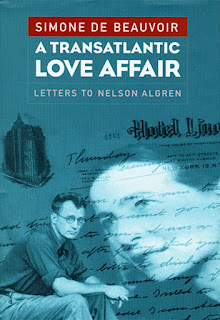Liz Harmer Reviews Great House by Nicole Krauss
Nicole Krauss's Great House has avoided the baggage of "women's fiction" pointed out by Meg Wolitzer in a recent New York Times article; unlike other contemporary novels written by women, the jacket of Great House
does not deal in domestic clichés, the "laundry hanging on a line. A
little girl in a field of wildflowers. A pair of shoes on a beach. An
empty swing on the porch of an old yellow house" (Wolitzer). Instead,
the cover is abstract, textual: a jacket which does not diminish the
strong, serious stuff within.
has avoided the baggage of "women's fiction" pointed out by Meg Wolitzer in a recent New York Times article; unlike other contemporary novels written by women, the jacket of Great House
does not deal in domestic clichés, the "laundry hanging on a line. A
little girl in a field of wildflowers. A pair of shoes on a beach. An
empty swing on the porch of an old yellow house" (Wolitzer). Instead,
the cover is abstract, textual: a jacket which does not diminish the
strong, serious stuff within.
Great House
is most remarkable in its central structuring device--it is anchored by
the heft of an old, somewhat monstrous desk, a desk which connects the
four otherwise disparate narrators weaving their dark tales. The first
is a female novelist who holds onto it for a Chilean poet who then
disappears from her life. The desk roots her to her apartment for
decades and guides the writing of each of her novels: "One drawer was
slightly ajar, one of the nineteen drawers, some small and some large,
whose odd number and strange array, I realized now . . . had come to
signify a kind of guiding if mysterious order in my life" (16). The
preoccupations of this narrator as she gives her life story to another
character, a judge in a hospital bed, revolve around this desk--her
memories of it, her grief--now that it has been retrieved by another of
the characters on behalf of the missing poet. Another narrator has given
his life to the pursuit of furniture that had been lost by the Jews in
the Holocaust. The novel, in some sense, is a lineage of the desk.
Virginia
Woolf wrote that a novel should have a vertical line going through it
as an organizing principle--the chiming of Big Ben in Mrs. Dalloway and the lighthouse in To the Lighthouse
and the lighthouse in To the Lighthouse --as though such a work is not a linear thing, moving ahead
chronologically, but a circling one, rippling outwards from a solid
centre. Though Great House spans full lifetimes, covering failed
relationships of all kinds and the mysteries people are to one another,
it does so anchored, always, by the enormous, ownerless desk.
--as though such a work is not a linear thing, moving ahead
chronologically, but a circling one, rippling outwards from a solid
centre. Though Great House spans full lifetimes, covering failed
relationships of all kinds and the mysteries people are to one another,
it does so anchored, always, by the enormous, ownerless desk.
The
lineage of the desk is, of course, fraught. Its owners have led tragic
lives, filled with secrets. The desk itself has a locked drawer: "The
drawer had been locked for as long as I could remember . . . . I always
instinctively reached for it first, awakening a kind of fleeting
unhappiness, a kind of orphaned feeling that I knew had nothing to do
with the drawer but had somehow come to live there" (21). All of the
feelings--the loneliness, confusion, rage, and unhappiness shared by the
characters--are orphans: we never truly understand their origins and
neither do the characters. Instead, we grope in the darkness of a novel
evocative of terror and refusing to explain.
Besides the structure, one other remarkable thing about Great House
is these evocations of terror: it is filled with imagery that works to
create both mood and suspense but never becomes properly symbolic.
Images and objects are not translated in a direct way into ideas;
instead, they communicate pain and terror without making their meaning
clearly known. The characters, similarly, are groping and do not share
their secrets with the reader. There is a story of a mother who burns
herself and her children to death. Furniture begins to seem like
decomposing bodies, and the first narrator's life turns edgy with
depression and anxiety when the desk is finally taken from her. Another
character is described by his narrator, his father, as nonhuman, as
strange: "There was a little moonlight, and from what I could see the
stick figure looked like neither a man nor a woman, and not a child
either. An animal, maybe. A wolf, or a wild dog" (63). Most secretive,
most traumatized is the character of Lotte Berg, who tells her husband
nothing of her experience during the war--the loss of her parents and
her home--and who takes daily swims in the "swimming hole" that gives
one of the chapters its title: "She'd approach the water's edge. For a
moment she would stand completely still. God knows what she thought
about. Up until last she was a mystery to me. . . . And then, in a
flash, she'd disappear into the darkness" (77). Characters are ghostly,
beastly, being swallowed up. Most fearsome of all is the titular great
house, a Victorian which has "gone to seed" (110). Like something in a
nineteenth-century Gothic, its inhabitants trap themselves miserably
there, a sister, a brother, and a difficult, obsessive father who leaves
to seek furniture lost during the Second World War: "Leah remembered
the arrival of certain of these long-lost pieces . . . , tense and
somber events that had terrified her so much as a small child she would
sometimes hide in the kitchen when the crates were pried open, in case
what popped out were the blackened faces of her dead grandparents"
(115).
Great House is haunted by
history. The repetition of all of these dark images, these secrets, as
well as the looming furniture and houses haunted not by literal ghosts
but by family pain, did make it feel to me like a Gothic novel. The
atmosphere is thick and eerie; the frightening mood and insinuation of
secrets enough in themselves to propel the narrative. Suspense is
strong, but, like everything in the book, somehow mysterious; I lapped
the pages up eagerly without understanding why I was so curious about
the life of the desk and its owners. The narrators take us through the
long stories of their lives and we follow willingly, afraid for and
compelled by the secret darkness at their heart.
Of
course, the novel is about alienation, about loss, about secrets, and
all of these images and stories--the monstrous furniture and terrible
deeds, the swimming holes and locked drawers, the blackened faces and
wolfish children--do some symbolic work. But I think that this is not,
primarily, how they function. Any such symbolism is interrupted and
indeterminate. Instead, they compel us to feel as the characters do, to
grope like they do, and to feel their fear. Objects first give life
texture, keep us company with their heft, their physical presence. The
desks that anchor our lives do so first actually and then
symbolically--first by being present and then by receiving the whole
confusion of meaning we wish to pour into them.
Review by Liz Harmer


